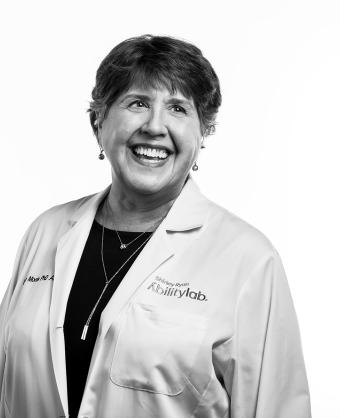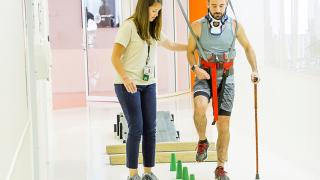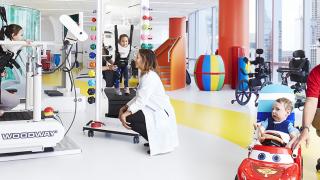Body
What’s different about vent weaning at Shirley Ryan AbilityLab?
Body
- A focus — Our Vent-weaning Program (what we call vent liberation) is a specialty in itself. Your vent-weaning team has decades of experience in helping SCI patients breathe independently (completely, or in longer intervals).
- A multidisciplinary team — Your care team is multidisciplinary and collaborative; all are SCI specialists in their respective disciplines. We also offer the expertise of every clinician in Shirley Ryan AbilityLab who treats neurological injury.
- Research-based evaluation — When you arrive, we micro-analyze the function of your respiratory muscles. We evaluate how strong or weak these muscles are using various methods of examining respiratory muscle function — such as inspiratory excursion measurements; traditional respirator measures; and a powerful and sophisticated imaging tool called diaphragm ultrasound.
- Diaphragm ultrasound allows us to better assess the function of breathing muscles for patients admitted on ventilator support — and to tailor care and interventions to help each individual achieve their best outcome. Further, with the vast amount of ultrasound data we have collected from this unique population of patients through our research, we are better able to predict overall ventilator weaning success.
- A different approach — Using targeted-muscle training, we focus on strengthening all functioning muscles used for breathing.
- We combine building strength with teaching you how to breathe differently. We help you increase the efficiency (decrease the work) of breathing.
- An early, proactive start — Your vent-weaning respiratory therapy is combined with three hours of additional inpatient rehabilitation therapy a day (physical, speech, occupational or psychological therapies). Often, you are co-treated in therapy; for example, your respiratory therapist and physical therapist might work together in the same session.
- Speeding recovery — Including vent weaning as part of acute inpatient rehabilitation maximizes recovery because you are active during the early, critical healing window. Muscle-wasting can begin in as little as 48 hours. In an acute-care setting, you would be inactive, waiting until your body can breathe on its own (the traditional “pass/fail” approach).
- Every minute of freedom counts — We coach you in time increments, focusing on gains. We take every minute off the vent as a gain, and then build on every one.
- The ideal goal is complete independence, but where achieving that level of independence is not possible, gaining valuable increments of vent-free breathing means fewer people are needed to help with bathing, transferring or going out into the community, and less stress should the power go out.
- Calming anxiety with answers — At every step of the way, we teach you and your family about the process. We coach you as we train you how to breathe differently, and we answer questions — about equipment, process or feelings. Most importantly, we demonstrate to you how we’re a team and that you can count on us.
How does the process work?
Body
Developing strong, independent breathing is an important part of the overall rehabilitation process and likely looks different than the ventilator-weaning protocols commonly used in other facilities. Some of the unique aspects of Shirley Ryan AbilityLab’s ventilator-liberation process follow.
- Arrival and Initial Transitioning — You will transfer to Shirley Ryan AbilityLab on full ventilator support, and we will watch over you for the first 48 hours to ensure that you are stable. This protocol applies to all patients, even if you have been participating in ventilator-weaning sessions prior to transfer.
We do so to make sure everyone coming to our hospital has safe, appropriate respiratory support throughout the high-risk period while transitioning care between facilities. After the initial monitoring period, we start weaning you off the vent.
- Trach-collar Trials — At your acute-care hospital, you may have been participating in a process of slowly reducing support from the ventilator. This approach is often called “CPAP” or “Pressure Support” trialing. This style of weaning is designed for patients with underlying lung injury or disease (for example, severe pneumonia, lung-scarring, severe COPD).
Because spinal cord injury does not involve the lungs, we work on strengthening the functioning breathing muscles by removing the vent at intervals and allowing for spontaneous breathing in a safe, monitored environment. This approach, the one we use at Shirley Ryan AbilityLab, is a different version of the pass/fail “trach-collar trialing,” which is used at some acute-care hospitals.
- Airway Clearance — Our respiratory therapists and/or speech therapists will add therapies to help open your airways and clear secretions. Your therapists will use devices such as CoughAssist, MetaNeb® and/or expiratory muscle-strength trainers to help strengthen your cough, clear your airways and reduce your risk of developing pneumonia.
- Positioning — Our physical therapists and wheelchair seating specialists will get you out of bed, support your core body and work on helping you mobilize your chest wall. This positioning optimizes your ability to breathe independently and will help you start breathing more easily.
- Alternatives — For those SCI patients whose injuries make full independent breathing impossible, we evaluate you for use of alternative therapies such as diaphragmatic pacers or noninvasive ventilation.
What Our Patients Are Saying About Our Program
Body
“The excitement of gaining more hours off the vent every day was the best. I was getting prouder, too. Just knowing my body was healing and allowing me to do that was exciting.”
“Now that I’m free of the vent, therapy is easier because I can move my neck. I also don’t have to wheel that whole thing everywhere, and it’s easier on my family too, less training to do.”
What Our Clinicians Are Saying
Body
“Working on an interdisciplinary team of such specialized individuals is very exciting. Each patient has a personal story about their breathing journey, and I love that we all take that journey together.”
- Erin Walaszek, PT, DPT
“It’s a privilege to work with such an amazing team of physicians, therapists and nurses, all focused on helping patients with catastrophic injuries optimize breathing function. Through our research-based, interdisciplinary treatment model, together we provide the best and most innovative medical and rehabilitation treatments to speed recovery.”
- Colin Franz, MD, PhD
“It’s been really fulfilling to develop our Vent-liberation Program, which creates a critical recovery and quality-of-life opportunity for patients. Our organic, interdisciplinary teamwork has been pivotal in the development of this program, and now, in working with the many patients who have benefited from participation. With the patient at the center, and greater independence in breathing the goal, the team draws upon the expertise of the physician, pulmonologist, respiratory therapist, physical therapist, speech-language pathologist, occupational therapist, nurse, psychologist, case manager and caregiver.”
- Kristen Forand, SLP (Senior SLP, Spinal Cord Innovation Center)




